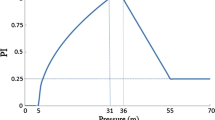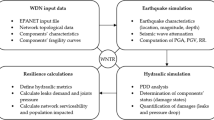Abstract
Seismic resilience of Sadra City water distribution network (WDN) is assessed. Complex networks theory is applied to model the WDN. Two hydraulic resilience indices including the population impacted (PI) and the water services availability (WSA) are employed. Nine scenarios considering the different earthquake intensities and epicenters are considered. The robust repair strategy is proposed considering two different perspectives, the maximum PI and WDN recovery time. Based on hydraulic resilience indices, north of Sadra City is the most vulnerable area and the network resilience is the highest in the south. Finally, employing fragility curve analysis, pipes with high probability of damage are detected to be enhanced to increase WDN resilience upon future disasters. The perspective of the WDN capacity to return to normal condition after the shock to the system is studied based on the concept of recovery time. The recovery time of the system in each scenario depicted significant correlation with the hydraulic indices.


















Similar content being viewed by others
Availability of Data and Materials
Some or all data and models that support the findings of this study are available from the corresponding author upon request. The corresponding author is ready to share data with other researchers who send their request to this Email address: fattahi.mh@gmail.com.
References
Agency FEM (2013) Multi-hazard loss estimation methodology, flood model, Hazus-MH. Technical Manual, Washington, DC
Alliance AL(ALA) (2001) Seismic fragility formulations for water systems, Part I-Guideline. ASCE
Bałut A, Brodziak R, Bylka J, Zakrzewski P (2019) Ranking approach to scheduling repairs of a water distribution system for the post-disaster response and restoration service. Water 11(8):1591. https://doi.org/10.3390/w11081591
Bruneau M, Chang SE, Eguchi RT, Lee GC, O’Rourke TD, Reinhorn AM, Shinozuka M, Tierney K, Wallace WA, Von Winterfeldt D (2003) A framework to quantitatively assess and enhance the seismic resilience of communities. Earthq Spectra 19(4):733–752. https://doi.org/10.1193/1.1623497
Ballantyne DB, Taylor C (1990) Earthquake loss estimation modeling of the Seattle water system using a deterministic approach. In Lifeline Earthquake Engineering (pp. 747–760). ASCE.
Chang SE, Shinozuka M (2004) Measuring improvements in the disaster resilience of communities. Earthquake spectra. 20(3):739–55
Chang YH, Kim JH, Jung KS (2012) A Study on the design and evaluation of connection pipes for stable water supply. J Korean Soc Water and Wastewater. 26(2):249–56
Cimellaro GP, Tinebra A, Renschler C, Fragiadakis M (2016) New resilience index for urban water distribution networks. J Struct Eng 142(8):C4015014. https://doi.org/10.1061/(ASCE)ST.1943-541X.0001433
Farahmandfar Z, Piratla KR, Andrus RD (2017) Resilience evaluation of water supply networks against seismic hazards. J Pipeline Syst Eng Practice 8(1):04016014. https://doi.org/10.1061/(ASCE)PS.1949-1204.0000251
Federal Emergency Management Agency. Evaluation of earthquake damaged concrete and masonry wall buildings. FEMA; 2013.
Giustolisi O, Savic D, Kapelan Z (2008) Pressure-driven demand and leakage simulation for water distribution networks. J Hydraul Eng 134(5):626–635
Grossel SS (2002) Chemical process safety: fundamentals with applications, (2002)-By Daniel A. Crowl and Joseph F. Louvar, Prentice Hall PTR, Upper Saddle River, NJ, pp. 642, $94.50. Journal of Loss Prevention in the Process Industries. 6(15): 565–6.
Holling CS (1973) Resilience and stability of ecological systems. Annu Rev Ecol Syst 4(1):1–23
Hunter JD (2007) Matplotlib: A 2D graphics environment. IEEE Ann Hist Comput 9(03):90–95
Hwang HH, Lin H, Shinozuka M (1998) Seismic performance assessment of water delivery systems. J Infrastruct Syst 4(3):118–125. https://doi.org/10.1061/(ASCE)1076-0342(1998)4:3(118)
Kawashima K, Aizawa K, Takahashi K. (1984) Attenuation of peak ground motion and absolute acceleration response spectra. In: Proceedings of eighth world conference on earthquake engineering (Vol. 2, pp. 257–264).
Klein RJT, Nicholls RJ, Thomalla F (2003) Resilience to natural hazards: how useful is this concept? Environ Hazards 5(1–2):35–45. https://doi.org/10.1016/j.hazards.2004.02.001
Klise KA, Murray R, Walker LT. (2015) Systems measures of water distribution system resilience. Sandia National Lab.(SNL-NM), Albuquerque, NM (United States);
Klise KA, Bynum M, Moriarty D, Murray R (2017) A software framework for assessing the resilience of drinking water systems to disasters with an example earthquake case study. Environ Model Softw 1(95):420–431. https://doi.org/10.1016/j.envsoft.2017.06.022
Klise K, Hart D, Bynum M, Hogge J, Haxton T, Murray R, Burkhardt J. (2020) Water Network Tool for Resilience (WNTR) User Manual. Sandia National Lab.(SNL-NM), Albuquerque, NM (United States)
Lambert A. (2001) What do we know about pressure-leakage relationships in distribution systems. In IWA Conf. n Systems approach to leakage control and water distribution system management
Liu W, Song Z (2020) Review of studies on the resilience of urban critical infrastructure networks. Reliab Eng Syst Saf 1(193):106617. https://doi.org/10.1016/j.ress.2019.106617
Liu W, Song Z, Ouyang M, Li J (2020) Recovery-based seismic resilience enhancement strategies of water distribution networks. Reliab Eng Syst Saf 1(203):107088. https://doi.org/10.1016/j.ress.2020.107088
May J. (1994) Pressure dependent leakage, World water environmental engineering
O'Rourke TD, Jeon SS (1999) Factors affecting the earthquake damage of water distribution systems. In Optimizing Post-Earthquake Lifeline System Reliability (pp. 379–388). ASCE
O’rourke TD, Jeon SS. (2000) Seismic zonation for lifelines and utilities. In Invited Keynote Paper on Lifelines. Proceedings sixth international conference on seismic zonation, Palm Springs, EERI CD ROM
Shi P, O'Rourke TD (2008) Seismic response modeling of water supply systems. Multidisciplinary Center for Earthquake Engineering Research
Taoan H, Bistra D (2020) Enhancing Seismic Resilience of Water Pipe Networks. In: ACM SIGCAS Conference on Computing and Sustainable Societies (COMPASS) (COMPASS ’20), Ecuador. ACM, New York, NY, USA, 9 pages. https://doi.org/10.1145/3378393.3402246
Todini E (2000) Looped water distribution networks design using a resilience index based heuristic approach. Urban Water 2(2):115–122. https://doi.org/10.1016/S1462-0758(00)00049-2
Toprak S (1998). Earthquake effects on buried lifeline systems”, PhD. Thesis, Cornell University.
Wagner JM, Shamir U, Marks DH (1988) Water distribution reliability: simulation methods. J Water Resour Plan Manag 114(3):276–294
Wei L , Zhaoyang S, Min O (2002) Lifecycle operational resilience assessment of urban water distribution networks, Reliability Engineering and System Safety, doi: https://doi.org/10.1016/j.ress.2020.106859
Yu YX, Jin CY (2008) Empirical peak ground velocity attenuation relations based on digital broadband records. In 14th World Conference on Earthquake Engineering
Zare N, Talebbeydokhti N (2018) Policies and governance impact maps of floods on metropolitan Shiraz (the first step toward resilience modeling of the city). Int J Dis Risk Reduction 28(2018):298–317. https://doi.org/10.1016/j.ijdrr.2018.03.003
Zhao X, Chen Z, Gong H (2015) Effects comparison of different resilience enhancing strategies for municipal water distribution network: A multidimensional approach. Mathematical Problems in Engineering. https://doi.org/10.1155/2015/438063
Acknowledgements
This article was excerpted from a Ph.D. thesis in Civil and Earth Resources Engineering Department of Tehran Central Branch, Islamic Azad University. The authors also express their sincere thanks and appreciations to Fars Water and Wastewater Company for their corporation to supply the required data including network maps, water network and pipe details and hydraulic features of the water system in the study area.
Author information
Authors and Affiliations
Corresponding author
Ethics declarations
Conflict of interest
The authors have no conflict of interest to declare.
Rights and permissions
Springer Nature or its licensor holds exclusive rights to this article under a publishing agreement with the author(s) or other rightsholder(s); author self-archiving of the accepted manuscript version of this article is solely governed by the terms of such publishing agreement and applicable law.
About this article
Cite this article
Nariman, A., Fattahi, M.H., Talebbeydokhti, N. et al. Assessment of Seismic Resilience in Urban Water Distribution Network Considering Hydraulic Indices. Iran J Sci Technol Trans Civ Eng 47, 1165–1179 (2023). https://doi.org/10.1007/s40996-022-00941-7
Received:
Accepted:
Published:
Issue Date:
DOI: https://doi.org/10.1007/s40996-022-00941-7




